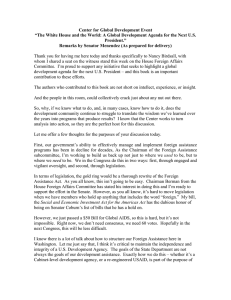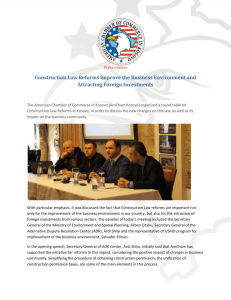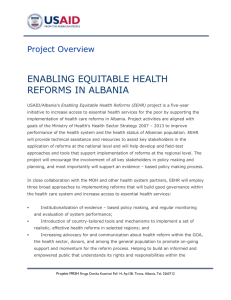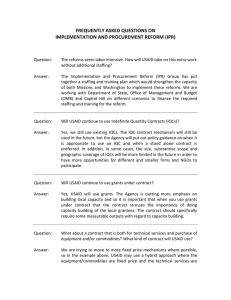THE SHAPE OF U.S. GLOBAL DEVELOPMENT REFORMS
advertisement
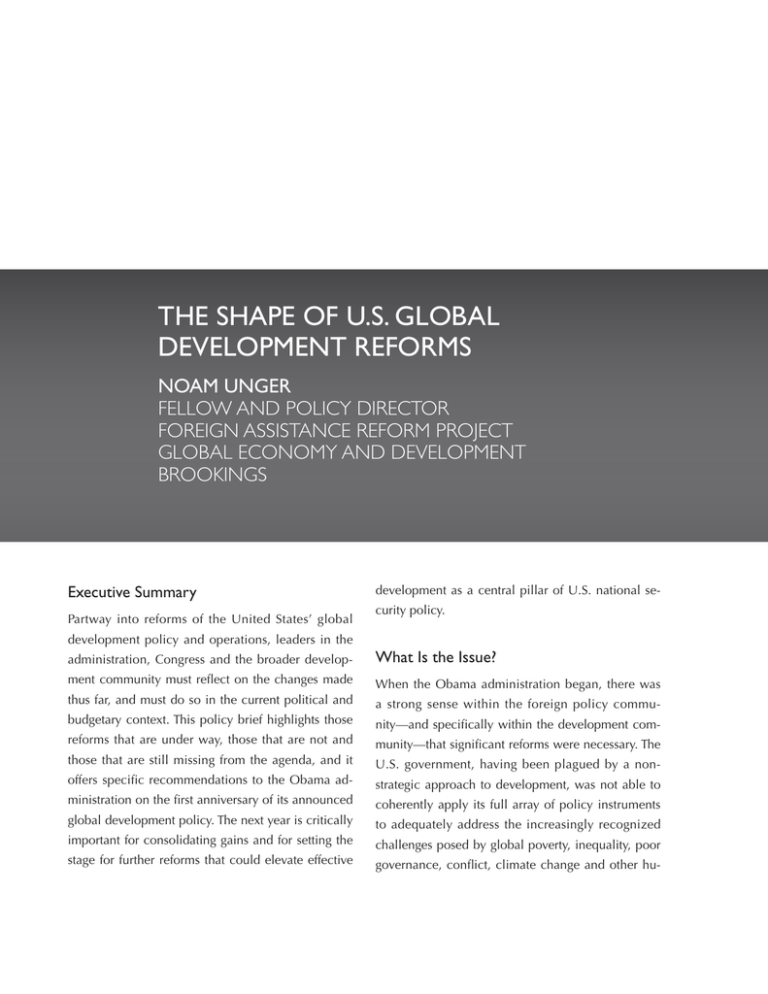
THE SHAPE OF U.S. GLOBAL DEVELOPMENT REFORMS NOAM UNGER FELLOW AND POLICY DIRECTOR FOREIGN ASSISTANCE REFORM PROJECT GLOBAL ECONOMY AND DEVELOPMENT BROOKINGS Executive Summary Partway into reforms of the United States’ global development as a central pillar of U.S. national security policy. development policy and operations, leaders in the administration, Congress and the broader develop- What Is the Issue? ment community must reflect on the changes made When the Obama administration began, there was thus far, and must do so in the current political and a strong sense within the foreign policy commu- budgetary context. This policy brief highlights those nity—and specifically within the development com- reforms that are under way, those that are not and munity—that significant reforms were necessary. The those that are still missing from the agenda, and it U.S. government, having been plagued by a non- offers specific recommendations to the Obama ad- strategic approach to development, was not able to ministration on the first anniversary of its announced coherently apply its full array of policy instruments global development policy. The next year is critically to adequately address the increasingly recognized important for consolidating gains and for setting the challenges posed by global poverty, inequality, poor stage for further reforms that could elevate effective governance, conflict, climate change and other hu- manitarian and human rights crises. A fragmented of the Quadrennial Diplomacy and Development aid infrastructure, a weakened U.S. Agency for Review in December 2010, which was similarly International Development, and an outdated morass the product of a lengthy process but centered at the of laws, coupled with distrust between Congress and State Department. An emerging set of agency-level the executive branch, resulted in inefficient aid prac- reforms, launched last year by the U.S. Agency for tices at a moment when U.S. development assistance International Development’s (USAID’s) new adminis- had grown considerably in financial terms. One trator, was incorporated into the QDDR. Essentially, critical question was whether the necessary reforms after a less-than-expeditious start, the administration’s would rise high enough on the foreign policy man- reform effort picked up pace and visibly took shape agement agenda of a government engaged in mul- within the past year. tiple wars and facing a global economic crisis. During nearly three years of the Obama adminInflated hopes among leading reform advocates gave istration, as reforms have been planned amid an way to dimmer prospects for early sweeping changes increasingly sophisticated policy dialogue on effec- to U.S. development efforts, as policymakers tended tive development support, the U.S. budget outlook to more immediate domestic and international priori- has unfortunately soured. Between 2000 and 2010, ties. The Obama administration launched new presi- U.S. investments in official development assistance dential initiatives in the areas of food security, global steadily increased from about $12 billion to just un- health and climate change, and it established these der $30 billion (in constant 2009 dollars), but severe initiatives with some development reform principles budget cuts are now on the table as the U.S. public in mind. But key development policy leadership po- focuses on economic woes. Funding levels for 2011 sitions remained vacant. After one year, however, were cut by 15 percent from Obama’s original request top international development positions started to be and 9 percent from 2010. For 2012 the Obama ad- filled across agencies, and multiple official policy re- ministration requested a marginal increase over 2010 views were under way. levels, but in light of budget levels already passed in the House of Representatives and caps imposed by 44 In September 2010, after many months of consulta- the recent debt deal and the accompanying Budget tion and deliberation, the White House unveiled Control Act, it is very likely that development spend- the president’s policy directive on development. ing will significantly decrease yet again in 2012. This PPD called for a stronger focus on sustainable Moreover, the part of the budget set aside for security- development outcomes; a modern organizational oriented overseas contingency operations is likely to structure that elevates development within foreign grow in 2012, meaning that the total budget number policy deliberations and ensures greater develop- for foreign assistance funding obfuscates the severity ment policy coherence across the range of U.S. of cuts for other types of development assistance. The government capabilities and instruments; and a new prospect for development assistance resources may operational model that leverages U.S. leadership even worsen in subsequent years as a result of loom- and makes it a more effective partner in support of ing spending cuts linked with broader efforts to curb development. This was followed by the publication the national deficit. FROM GLOBAL AID TO DEVELOPMENT COOPERATION The political landscape related to U.S. global de- elected in 2012. If he is not reelected, a new admin- velopment efforts has also shifted. Republicans took istration will need to assess current U.S. development control of the House of Representatives this year, policies and modernization processes and decide making it even more difficult for Congress to pass what to continue and what to abandon. Either way, legislation favorable to the Obama administration’s the next year is critically important. agenda. And even though a bipartisan consensus seemingly formed around support for U.S. foreign assistance during the past decade, this accord has What Needs to Happen—and Why? proven susceptible to current budget pressures, as What’s Moving? evidenced by the support for massive cuts in discre- Some of the reforms announced in conjunction with tionary spending on international affairs. the administration’s reviews are already under way in terms of structural or procedural changes. For ex- Additionally, 10 years into America’s longest war, a ample, under the leadership of Administrator Rajiv weary U.S. electorate may be more attuned to criti- Shah, USAID has prioritized a package of proposed cism of nation-building efforts in Afghanistan, where improvements, collectively branded as “USAID the U.S. has spent more than $18 billion since 2002 Forward.” (or more than $51 billion, if Department of Defense security and stabilization assistance is also counted). Many initiatives are actively under way in line with Afghanistan has now surpassed Iraq as the top recipi- the key priorities for USAID Forward. An Office of ent of American foreign aid and the politics surround- Budget and Resource Management has been estab- ing relief and development are also being shaped by lished, reequipping the agency with some of the bud- revolutions across the Middle East and North Africa, get execution responsibilities that had been moved to along with heightened instability in Pakistan and the State Department under the last administration. other countries—like Haiti and Sudan—that are tee- A new Bureau for Policy, Planning and Learning has tering on the brink of high-profile disasters. also now been set up to fill a void, positioning USAID to become a more strategic and influential institution It is within this context of changing policies and bu- that benefits from research and lessons from the field. reaucracies, budgetary pressures and global politics This bureau oversees the newly established Country that the reform of U.S. global development efforts Development Cooperation Strategy process to pro- must be assessed. Some necessary reforms have been vide better focus and results at the country level. As decided on and announced; others must be consid- USAID’s policy capacity is being rebuilt, it is already ered and acted upon. Some of the announced reforms yielding new agency-wide policies and strategies, are being quickly implemented, while others are not. such as an evaluation policy meant to revitalize and Some improvements are contingent on budgets and restore the integrity of analytical judgments about Congress, while others are less so. programs and projects. Further progress on reform in the coming months The focus on evaluation dovetails with stronger could set the stage for more fundamental steps to monitoring and transparency to constitute another strengthen development if President Obama is re- THE 2011 BROOKINGS BLUM ROUNDTABLE POLICY BRIEFS 45 pillar of USAID Forward. The drive for greater trans- wide reforms also place a premium on a modernized parency throughout foreign aid has resulted in the approach to human resources that could enable more creation of a public Web site—the Foreign Assistance recruitment and that, among other aims, seeks to bet- Dashboard, which helpfully synthesizes publicly ter leverage existing expertise—especially among available State Department and USAID budget and Foreign Service nationals. Another identified priority appropriation data on foreign assistance in a user- is the reform of aid implementation and procurement friendly and accessible way. As clearly indicated on policies and processes. this Web site, however, the administration recognizes that the dashboard efforts to date are only a first step Actually, many specific ongoing changes constitute (see figure 1). USAID Forward. Some activities, like the dashboard or the establishment of new offices, are easy to iden- USAID Forward also prioritizes innovation, science tify, but others are less visible because they involve and technology, leading the agency into new re- process and cultural changes within the agency. In search partnerships and more creative efforts to invest each of these efforts, the key is to continue the mo- in entrepreneurial and potentially catalytic efforts mentum and fully operationalize changes. This is also dependent on skilled risk management. The agency- true for the effort that is still behind the scenes to pilot Figure 1. Foreign Assistance Dashboard Data “Below is a matrix of the data currently available on this site and a preview of the data that will be added over the coming months. While only a few agencies are listed here, the aim of the Dashboard is to include all USG agencies receiving or implementing foreign assistance, humanitarian, and/or development funds. This matrix will be updated as additional data sets are added.” Source: ForeignAssistance.gov Agency Request Appropriation U.S. Agency for International Development X X Department of State X X Obligation Department of Labor Department of Defense Department of the Treasury Millennium Challenge Corporation (MCC) Department of Agriculture Export-Import Bank of the U.S. Peace Corps Source: The U.S. government Web site http://foreignassistance.gov. 46 FROM GLOBAL AID TO DEVELOPMENT COOPERATION Expenditure Project Information Peformance Data a coordinated interagency “Partnership for Growth” herence. Yet the administration has not released any approach that fosters complementarity as well as further information on these two agenda items. host-country consultation to jointly tackle key economic constraints. Reforms must reach the field and Although the lack of a full-fledged development make a sustainable, positive difference in developing strategy may stem from fatigue in the aftermath of countries. For example, though broader procurement the drawn-out policy and capability reviews, and reforms are apparently moving along in tandem with though silence on creating an advisory council may the other priorities of USAID Forward, there is still a be attributed to a bottleneck in the queue of reforms, long way to go and many thorny issues must still be advances related to conflict prevention and crisis re- resolved in efforts to streamline processes, form effec- sponse capabilities may be more deeply mired. The tive partnerships with other actors and align programs issue of how to deal with complex crises and con- with host-country needs and priorities. flicts was central to the QDDR, but its recommendations have not yet led to commensurate progress. What Is Not Moving? Although many ongoing activities within USAID represent announced modernization efforts that are advancing, other announced reforms are still ill defined or lagging. To achieve a modern architecture, for example, the president’s policy directive on development stated that the administration would “establish mechanisms for ensuring coherence in U.S. development policy across the United States government.” In accordance with the PPD, the National Security Staff reestablished an interagency policy committee on global development, which convenes relevant agencies to facilitate decisionmaking, set priorities and coordinate efforts. But the PPD also called for the routine formulation of a presidentially approved U.S. Global Development Strategy and the creation of a U.S. Global Development Council, comprising leading members of the philanthropic sector, private sector, academia and civil society. Both a strategy document and an advisory council are likely to be more outwardly visible than the quiet work of an interagency policy committee behind closed doors, but despite this symbolic value, they should not be for show. Each in its own way can strengthen policy co- The top-line recommendation for “a lead-agency approach between the State Department and USAID based on clear lines of authority” is based on a distinction—between political and security crises on one hand and humanitarian crises on the other—that is often blurred in reality. Progress has also been slow in implementing other key recommendations, such as reshaping the State Department’s pertinent structures by creating a new undersecretariat for civilian security, democracy and human rights and by creating a new Bureau for Conflict and Stabilization Operations. Leadership announcements for these new structures have not been made, but many of the relevant implementation decisions will only be made and executed by designated leaders armed with a mandate. Also, the larger challenge of whether to use civilian or military resources to deal with conflict and instability may be moving in the opposite direction. The QDDR touted the growth of U.S. civilian leadership in dealing with front-line states, noting that “[the State Department] has assumed leadership of the Pakistan Counterinsurgency Capability Fund.” However, control of the fund was transferred back to the Pentagon this year because it is politically easier to fund activities through the Defense Department. THE 2011 BROOKINGS BLUM ROUNDTABLE POLICY BRIEFS 47 The area of global health presents an additional con- thwart necessary reforms advanced by the administra- cern. President Obama’s stated policy is to rebuild tion. The president’s policy acknowledges all this and USAID “as the U.S. government’s lead development explicitly calls for a new partnership with Congress. agency.” USAID Forward can help with the internal strengthening of the agency, and the QDDR resolved Through its reforms, the Obama administration is the nebulous leadership of the president’s global hun- seeking to deliver a more strategic focus, greater ger and food security initiative, “Feed the Future,” by transparency and better accountability for results. But clearly delegating control to USAID. But whereas the so far it has largely sought to do so without adequately QDDR also explicitly concludes that USAID should consulting even the most sympathetic champions for lead the president’s initiative on global health, it set development reforms on Capitol Hill. In hesitating a target date of September 2012 for this transition to engage Congress, the administration may have “if defined benchmarks are met.” The QDDR’s 10 missed important opportunities to consolidate politi- benchmarks represent important goals. However, the cal and financial support for key initiatives, such as process of measuring USAID’s progress—whether food security and strengthened evaluation. Doing against individual targets or the set of benchmarks— more to engage Congress is in the administration’s is ill defined and prone to subjective assessment. As interest to gain overall support for the development a result of the fact that this politically charged deci- budget, to make progress on current reforms, and ul- sion was made to look like a technical fix, doubts re- timately to replace the morass of outdated legislation main concerning the transition to USAID leadership. that governs U.S. global development support. Global health is a core development priority, but it is challenging for USAID to be the lead U.S. development agency when it is not clearly the lead agency for the president’s global health initiative, which constitutes more than 25 percent of global assistance resources. Finally, within the ongoing dialogue on the reform of U.S. global development policy and operations, a grand bargain between Congress and the administration is widely viewed as necessary to achieve lasting improvement. The theory is that if Congress is better informed and has greater trust in the approaches and accountability systems of the executive branch, the executive branch will be afforded the flexibility it needs to be more effective. This flexibility means far fewer legislated directives and earmarks that limit the options for development support on the ground. Members of Congress are in a position to support or 48 FROM GLOBAL AID TO DEVELOPMENT COOPERATION What Is Missing? Major structural reforms were overlooked, dismissed or intentionally left out of the administration’s public agenda of changes. The organizational fragmentation of the U.S. aid and development infrastructure is a fundamental issue. More than 20 different agencies are responsible for development assistance across the U.S. government, leading to overlaps and gaps along with disunity, which weakens the development voice within foreign policy and national security decisionmaking. For example, USAID may assume leadership over the Global Health Initiative in accordance with the QDDR, but the QDDR also explicitly states that the Office of the Global AIDS Coordinator at the State Department will remain separate from USAID. This office has the statutory authority and responsibil- ity for coordinating, overseeing and managing all ence with the military must ultimately be addressed aspects of the President’s Emergency Plan for AIDS at levels higher than a capabilities review of the State Relief (PEPFAR), which accounts for the overwhelm- Department and USAID. For example, a persistent ing majority (roughly 64 percent) of global health challenge for U.S. peace-building and state-building funding. In countries where U.S. assistance is domi- efforts in fragile, conflict-affected regions is that of co- nated by AIDS-related programming, this organiza- ordination across all relevant departments and agen- tional structure could continue to pose a challenge. cies, including the Defense Department. This issue was largely beyond the scope of the QDDR, given Similar challenges remain unresolved even with that a robust White House coordination capacity, current reforms across the U.S. government, includ- rather than a State Department or USAID capacity, ing the separate status of the Millennium Challenge is necessary for high-profile interagency efforts that Corporation (MCC), the Overseas Private Investment heavily involve the military. Corporation (OPIC), the U.S. Trade and Development Agency (USTDA) and others. Important elements of development assistance are also managed by the State, Treasury, Health and Human Services and Defense departments, to name a few. There are many reasons why such institutional responsibilities were established apart from the U.S. agency ostensibly responsible for international development efforts, but in the context of far-reaching reforms and a presidential directive to “elevate development as a central pillar of our national security policy, equal to diplomacy and defense,” it makes sense to try to consolidate some agencies. Beyond even the most straightforward consolidation of development agencies and activities, other structural issues remain concerning the roles of the State Department, the Defense Department and the White House as they relate to development and humanitarian assistance. The role of the Defense Department in foreign policy served as a shadow over the QDDR, which consciously tried to take on characteristics of the Quadrennial Defense Review in order to push back against expanding military missions and authorities by making the case for greater “civilian power” to advance American interests. But the balance of influ- Leading Internationally With so much impetus for change, it would be easy for U.S. development officials to get caught up in the internal reform of their own system, but this introspection is happening at a critical time globally and must progress while the U.S. also leverages opportunities to lead internationally. After an era of growing official aid budgets and proliferating development actors, significant attention is now focused on making the dysfunctional international architecture more effective in support of development and aid. As demonstrated at previous Group of Eight and Group of Twenty meetings, as well as by increased engagement with the Organisation for Economic Cooperation and Development (OECD) and high-level strategic and economic dialogues with key partner countries, the Obama administration is interested in advancing development issues through international forums. The PPD was announced as part of the president’s address at the UN 2010 Millennium Development Goals Summit. Leveraging U.S. leadership, forging a division of labor among international partners and strengthening key multilateral capabilities are important parts of this new policy. THE 2011 BROOKINGS BLUM ROUNDTABLE POLICY BRIEFS 49 With serious policy reviews under its belt and some With many moving pieces of a change agenda at the encouraging reforms under way, the U.S. administra- agency and operational level, the administration must tion is now in a good position to push internationally not lose sight of its policy’s bolder elements, such as for tangible steps that will increase the effectiveness the push for a coherent approach to development of development support. The Group of Twenty (G-20) support across the U.S. government. Moreover, the meetings, the upcoming High-Level Forum on Aid administration must become even bolder by laying Effectiveness and the U.S. chairmanship of the 2012 the groundwork for significant and politically tricky G-8 all present opportunities for U.S. leadership. structural reforms. The next presidential term will As world leaders seek to achieve the Millennium bring new opportunities, and planning should begin Development Goals but also look beyond the MDG now for bigger changes in 2013 that could further el- agenda to forge a new framework for effective global evate effective and efficient U.S. global development development partnerships, the U.S. must play an ac- efforts. tive and central role. Recommendations and Next Steps In addition to these recommendations, the administration should specifically: Delivering on many priorities is clearly a challenge, and progress across all areas understandably cannot Complete the Foreign Assistance Dashboard. happen apace. The conclusions of an OECD–DAC Commit to a timeline with benchmarks along the peer review of U.S. development cooperation were way for the inclusion of new categories of data. just released in July, and September marks the anniversary of President Obama’s announcement of a Establish the U.S. Global Development Council. new global development policy. The administration This external advisory board should be created should use these opportunities to assess the early im- as soon as possible, still during 2011, so that it is plementation of its announced modernization efforts fully operating well before the end of the current and to rededicate itself to fundamental reforms. presidential term. (For more recommendations on the U.S. Global Development Council’s cre- Across many aspects of USAID Forward and the re- ation, mission, membership and other character- formist approaches to implementing the food security istics, see Unger and Norris 2011.) and global health initiatives, the key is to expand upon the initial implementation efforts. The work Lead the international charge for development to reshape bureaucratic cultures and systems must effectiveness. The U.S. must specifically seize the proceed, and some more visible aspects of mod- opportunity to engage robustly at the Busan High- ernization can also be helpful while demonstrating Level Forum relative to its engagement at past fo- the administration’s ongoing commitment to its own rums on aid effectiveness. USAID Administrator game-changing policies. Shah and other U.S. global development leaders are well positioned to come armed with credible 50 FROM GLOBAL AID TO DEVELOPMENT COOPERATION ideas and momentum. Additionally announc- Begin planning now for consolidation in 2013. ing the attendance of Secretary of State Hillary Just as the decision was made to have USAID Clinton could catalytically leverage her interna- oversee the president’s food security initiative tional star power to bring greater political heft and eventually the global health initiative, the and attention to the forum while demonstrating reforming lead development agency should be an increased importance for development issues granted oversight of signature presidential initia- within U.S. foreign policy. The U.S. must also tives that were established in separate institutions continue to encourage broader development sup- under the last administration—PEPFAR and the port at the G-20, which has become the more ap- MCC. These newer programs were developed on propriate forum—relative to the G-8—in which the cutting edge of best practices in aid manage- to exert leadership on development effectiveness. ment and delivery. Their experiences have shaped As the chair of the G-8 in 2012, the U.S. must be the current reforms, and their orderly integration mindful to support rather than undercut a stron- under one line of development authority must be ger G-20 role on development issues. (For more done in a way that preserves and propagates their recommendations on international leadership operational strengths while ensuring greater effi- opportunities and responsibilities for the U.S. in ciency and coherence. Additional organizational relation to development effectiveness, see Kharas integration involving independent development- and Unger 2011.) oriented programs should also be considered on the basis of synergy and efficiency. OPIC, for Further strengthen USAID’s voice in and respon- example could continue to exist under a more sibility for budget decisions and formulation. This unified development organization while expand- is an important measure of the true elevation of ing to absorb certain elements within USAID that development and USAID’s leadership. are also focused on unlocking private capital, such as the Development Credit Authority. The Explicitly build new mechanisms and capacity financial returns generated by these investments for routine assessments of U.S. domestic and could be reinjected into U.S. global development international policies based on development im- support. The USTDA could also be integrated in pact. U.S. military sales, agricultural subsidies, this way, as could elements of development assis- trade agreements and immigration policies, for tance managed by the Treasury and State depart- example, may have a significant impact on de- ments. For example, just as the QDDR calls for a velopment in partner countries. The PPD mildly review of the “best location for the political man- promotes consideration of development impact, date” of USAID’s Office of Transition Initiatives, but with few details and only “through existing implying that the office might best be housed policy mechanisms,” such as the Trade Policy within the State Department, the administration Review Group. Where policy mechanisms do not might equally review the location of the State exist, they should be created and aligned with a Department’s refugee assistance programs given cohesive approach that determines which poli- USAID’s humanitarian assistance mandate. cies are assessed when, how and by whom. THE 2011 BROOKINGS BLUM ROUNDTABLE POLICY BRIEFS 51 Approach Congress more strategically on development resources and reform. Congressional buy-in will be necessary to enact agency consolidation and operational changes involving new approaches and resources. To lay the groundwork for reasonable resource decisions in the immediate future and legislative reforms in the next few years, the administration must put forward the right leaders and teams to engage Congress and build the public case. President Obama should finally nominate someone to lead USAID’s Legislative Affairs Bureau. In these hard budgetary times, the administration must actively consult new and old champions from both political parties to forge strong relationships and build a shared executive–legislative vision for the U.S. approach to development while pushing reforms on the basis of efficiency and effectiveness. References Unger, Noam, and John Norris. 2011. “The U.S. Global Development Council: What Should It Look Like?” Brookings, April 8, http://www. brookings.edu/papers/2011/0408_development_ council_unger.aspx/ Kharas, Homi, and Noam Unger. 2011. “A Serious Approach to Development: Toward Success at the High Level Forum on Aid Effectiveness in Busan, Korea” Brookings, April 15, http://www. brookings.edu/papers/2011/0415_busan_success_kharas_unger.aspx/ 52 FROM GLOBAL AID TO DEVELOPMENT COOPERATION
